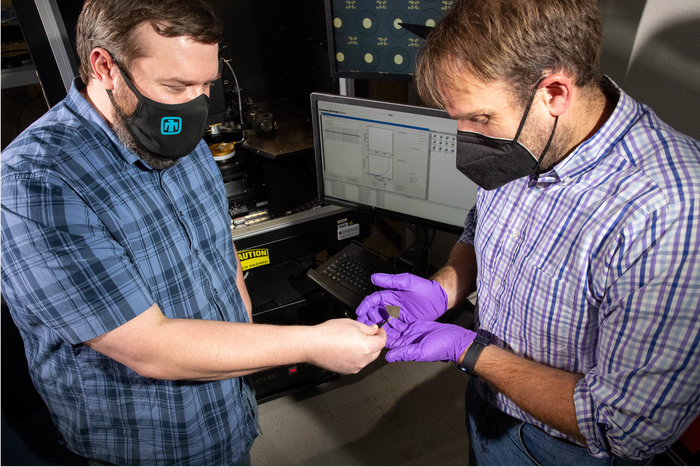6,400V GaN diode can protect the grid from EMPs

New Sandia diode can shunt excess electricity in a few billionths of a second
Scientists from Sandia National Laboratories in the USA have announced a GaN-based diode that can shunt excess electricity within a few billionths of a second while operating at a record-breaking 6,400 volts — a significant step towards protecting the nation’s electric grid from an electromagnetic pulse.
The team published the fabrication and testing results of their device on March 10 in IEEE Transactions on Electron Devices. The team’s ultimate goal is to provide protection from voltage surges, which could lead to months-long power interruptions, with a device that operates at up to 20,000 volts.
An electromagnetic pulse, or EMP, can be caused by natural phenomena, such as solar flares, or human activity, such as a nuclear detonation in the atmosphere. An EMP causes huge voltages in a few billionths of a second, potentially affecting and damaging electronic devices over large swaths of the country.
EMPs are unlikely, said Bob Kaplar, manager of a semiconductor device research group at Sandia, but if one were to occur and damage the huge transformers that form the backbone of our electric grid, it could take months to replace them and re-establish power to the affected portion of the nation.
“The reason why these devices are relevant to protecting the grid from an EMP is not just that they can get to high voltage — other devices can get to high voltage — but that they can respond in a couple billionths of a second,” Kaplar said. “While the device is protecting the grid from an EMP, it’s at a very high voltage and thousands of amps are going through it, which is a huge amount of power. A material can only handle so much power for a certain amount of time, but we think the material in our diode has some advantages over other materials.”
The new Sandia device can shunt a record-breaking 6,400 volts of electricity within a few billionths of a second — a significant advancement toward being able to protect the nation’s electric grid from an EMP. The team, including Sandia electrical engineer Luke Yates, the first author on the paper, is working towards fabricating a diode able to operate at around 20,000 volts, since most grid distribution electronics operate at around 13,000 volts.
Part of what makes this GaN diode special is that it can hold off much higher voltage before it breaks down than silicon, said Mary Crawford a Sandia Senior Scientist leading diode design and fabrication for the project said. The material itself also responds very quickly and therefore is a good candidate to achieve the fast response needed to protect the grid from an EMP.
Crawford and materials scientists Brendan Gunning and Andrew Allerman made the devices by GaN semiconductor layers using CVD. By tweaking the ingredients and the “baking” process, the team could produce layers with different electrical properties. By building up these layers in a specific order, combined with processing steps, such as etching and adding electrical contacts, the team produced devices with the needed behavior.
“A major challenge of achieving these very high voltage diodes is the need to have very thick gallium nitride layers,” Crawford said. “The drift regions of these devices have thicknesses of about 50 microns, or 1/6th of a sheet of notebook paper. This may not sound like a lot, but the growth process we use can have growth rates of only one or two microns per hour. A second major challenge is maintaining very low densities of crystalline defects, specifically impurities or missing atoms in the semiconductor material, throughout the growth time in order to generate devices that work at these very high voltages.”
For the team to reach their ultimate goal of a device that operates at 20,000 volts, they will need to grow the thick layer even thicker with even fewer defects, Crawford said. There are several other technical challenges to constructing a device that can operate at such high voltages and currents, she added, including designs to manage the very high internal electric fields within the devices.
Useful for smart transformers, solar panel converters and more
Diode devices like the Sandia GaN diode can be used for other purposes, beyond protecting the grid from EMPs, Kaplar said. These include smart transformers for the grid, electronic devices to convert electricity from roof-top solar panels into power that can be used by household appliances, and even electric car charging infrastructure.
Commonly, solar panel converters and electric car charging infrastructure can handle 1,200 or 1,700 volts, he added. But operating at higher voltage allows for higher efficiencies and lower electricity losses. Another portion of the project is to develop diodes for these types of devices that operate at high, but not record-breaking voltage but are easier to manufacture, Kaplar said. The Naval Research Laboratory is leading this part of the project.
Some smart transformers and electronic devices can now operate at up to 3,300 volts, but efficiencies would be even greater if they could operate at 10,000 or 15,000 volts with one semiconductor device.
“We have this primary goal of protection of the electrical grid, but these devices have other uses beyond that,” said Jack Flicker, a Sandia electric grid resiliency expert on the team.. “It’s interesting to have our application area, but know that these devices can be used in power electronics, power converters, everything that’s at very high voltages.”
This research is funded by ARPA-E and the larger project is conducted in partnership with the Naval Research Laboratory, Stanford University, National Institute of Standards and Technology, EDYNX and Sonrisa Research.
Pictured above: Luke Yates, left, passes a GaN wafer to Jack Flicker, a grid resiliency expert.
REF
'Demonstration of >6.0-kV Breakdown Voltage in Large Area Vertical GaN p-n Diodes With Step-Etched Junction Termination Extensions' by Luke Yates et al; IEEE Transactions on Electron Devices (2022)


































